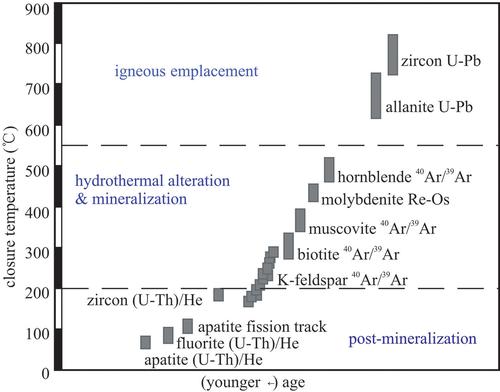当前位置:
X-MOL 学术
›
Acta Geol. Sinica Engl. Ed.
›
论文详情
Our official English website, www.x-mol.net, welcomes your feedback! (Note: you will need to create a separate account there.)
Timing and Processes of Ore Formation in the Qingchengzi Polymetallic Orefield, Northeast China: Evidence from 40Ar/39Ar Geochronology
Acta Geologica Sinica-English Edition ( IF 3.3 ) Pub Date : 2020-06-26 , DOI: 10.1111/1755-6724.14370 Yinzhi WANG 1, 2 , Fei WANG 1, 2, 3, 4 , Wenbei SHI 1, 2 , Liekun YANG 1, 2 , Lin WU 1, 2
Acta Geologica Sinica-English Edition ( IF 3.3 ) Pub Date : 2020-06-26 , DOI: 10.1111/1755-6724.14370 Yinzhi WANG 1, 2 , Fei WANG 1, 2, 3, 4 , Wenbei SHI 1, 2 , Liekun YANG 1, 2 , Lin WU 1, 2
Affiliation

|
The Qingchengzi orefield is a large polymetallic ore concentration area in the Liaodong peninsula, northeastern China, that includes twelve Pb‐Zn deposits and five Au‐Ag deposits along its periphery. The ore‐forming age remains much disputed, which prevents the identification of the relationship between the mineralization and the associated magmatism. In this paper, we quantitatively present the feasibility of making ore mineral 40Ar/39Ar dating and report reliable 40Ar/39Ar ages of lamprophyre groundmass, K‐feldspar and sphalerite from the Zhenzigou deposit. Direct and indirect methods are applied to constrain the timing of mineralization, which plays a vital role in discussing the contribution of multistage magmatism to ore formation. The low‐potassium sphalerite yielded an inverse isochron age of 232.8±41.5 Ma, which features a relatively large uncertainty. Two lamprophyre groundmasses got reliable inverse isochron ages of 193.2±1.3 Ma and 152.3±1.5 Ma, respectively. K‐feldspar yielded a precise inverse isochron age of 134.9±0.9 Ma. These four ages indicate that the mineralization is closely associated with Mesozoic magmatism. Consequently, regarding the cooling age of the earliest Mesozoic Shuangdinggou intrusion (224.2±1.2 Ma) as the initial time of mineralization, we can further constrain the age of the sphalerite to 224–191 Ma. These new and existing geochronological data, combined with the interaction cutting or symbiotic relationship between the lamprophyre veins and ore veins, suggest that the Pb‐Zn‐Au‐Ag mineralization in the Qingchengzi orefield mainly occurred during three periods: the late Triassic (ca. 224–193 Ma), the late Jurassic (ca. 167–152 Ma) and the early Cretaceous (ca. 138–134 Ma). This polymetallic deposits are shown to have been formed during multiple events coinciding with periods of the Mesozoic magmatic activity. In contrast, the Proterozoic magmatism and submarine exhalative and hydrothermal sedimentation in the Liaolaomo paleorift served mainly to transport and concentrate the ore‐forming substances at the Liaohe Group with no associated Pb‐Zn‐Au‐Ag mineralization.
更新日期:2020-06-26


























 京公网安备 11010802027423号
京公网安备 11010802027423号